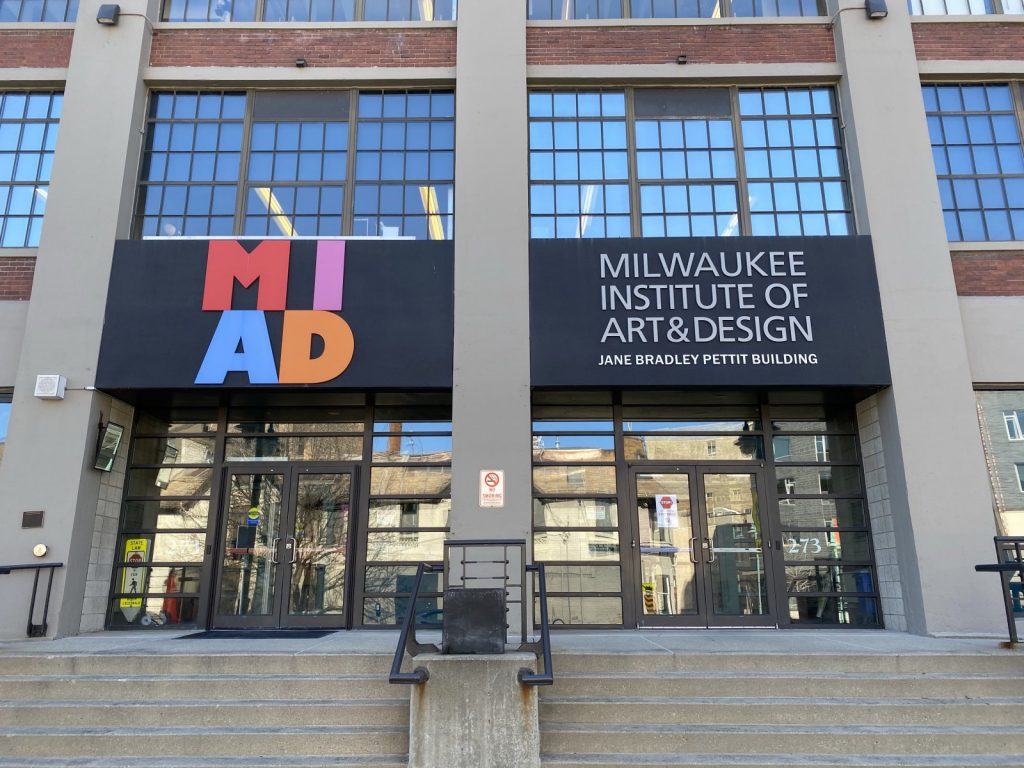MIAD Faces Huge Shortfall, Staff Cuts
Decisions on $2.8 million budget shortfall made with lack of transparency, some complain.
The Milwaukee Institute of Art & Design faces a shortfall of at least $2.8 million and has made buyout offers to some senior faculty and may ask remaining faculty to increase their course load, Urban Milwaukee has learned.
MIAD president Jeff Morin told Urban Milwaukee the college has asked departments to reduce their budget requests by 10% to 11%, but said when you eliminate “wish list” requests of added staffing and funding, the true reduction would be more like 7% to 8%. He declined to say how much that amounted to or what MIAD’s current budget is, but its most recent federal tax form, for 2022, showed a budget of $39.6 million, which would mean the college faces a shortfall of some $2.8 million.
MIAD staff have complained about a lack of “transparency” in the budget cuts being made. “This city is too small for the administration to make these decisions in a silo,” said Josh Hintz owner of the Var Gallery and a MIAD graduate who is close to many staff and students. MIAD’s graduates work in design jobs at many Milwaukee companies and the college is a key arts institution in the city and important part of the Third Ward.
Sources have told Urban Milwaukee that MIAD plans to offer early retirement packages to a number of senior faculty members. “I know three faculty who were offered this and have heard the total number will be seven,” said a staff member.
“It’s the highest paid faculty that are being targeted,” said a retired professor.
Morin told Urban Milwaukee “we have have offered a retirement incentive to some faculty,” but said the decisions are “not based on salary.” He declined to say how many buyouts are being offered. “That is not a number I’m going to put out there. We’ve worked very closely with employment attorneys and we’ve been advised not to share the information broadly.”
Hintz said that laying off so many senior faculty would be very harmful to the institution. “It’s the teachers who make that school what it is.”
Morin said he agreed “the teachers at the college are very important,” and helped MIAD increase its freshmen retention numbers.
Sources have also said that all full-time faculty will be asked to increase their workload from three courses to four courses per semester. “It is one of the proposals academic affairs is looking at,” Morin said.
Another complaint is that Morin asked that the faculty handbook be suspended for a year. “It just seems ridiculous,” said a MIAD staffer.
Morin denied this, but conceded there was a discussion about some details of the handbook. “I will say there has been a discussion at the Faculty Senate. We are trying to get the budget down by June.”
Another reason for the furor among staff, Hintz said, is that the administrative staff are not taking cuts in pay, but are asking faculty to bear the brunt of the budget cuts.
But Morin told Urban Milwaukee the administrative staff, including him, “will have a salary reduction.” Morin earned $281,000 in 2022, according to its federal tax form.
Will the administrative staff get a 7% reduction in pay? “I’m not going to discuss that,” Morin said.
As for the issue of transparency, Morin said at least “a dozen people at MIAD are working on the budget issue. It’s not being done just by senior administrative staff.”
MIAD’s budget has always been heavily driven by student fees and tuition, accounting for 94% of its revenue in 2022, according to its federal tax form.
Morin estimates that 40% of its students are from low-income families that depend on Pell grants and delays in the federal rollout of a new financial aid process has left students unsure of their ability to afford tuition, leaving MIAD with uncertainty, as it can only count students it is sure will be attending.
Morin noted that many arts schools and some private liberal art colleges are heavily reliant on tuition and fees. But some of them may have a higher endowment, providing some money to cushion ups and downs in enrollment.
Morin estimated that MIAD had an endowment of $3.5 million. The typical annual spinoff from an endowment like that would be $175,000, an amount so tiny it would give MIAD little wiggle room. “We do not carry a deficit from year to year,” Morin said.
“It’s been a challenge for the school to build an endowment,” said Jill Sebastian, an emeritus professor of sculpture for MIAD who taught there for 34 years.
Sebastian also noted that MIAD was a school started by faculty, who thus had considerable say over the institution in its early days. When the old Layton School of the Arts closed in the early 1970s, seven of its faculty members created their own independent college – originally called the Milwaukee School of the Arts, but now known as MIAD.
The school had periodically faced financial problems, she noted, including a time in the late 1990s when it had to cut the budget by 20%. But the problem was handled with the involvement of all staff, she noted. “The entire staff took a 20% cut in pay, down to the secretaries and people who pushed a broom.”
This time around, she said “there is not a feeling of us being asked to be part of the solution. They act like MIAD is a factory and the decisions come from the top down.”
The reason it’s being down this way, Sebastian contended, is “because it’s more complicated” to involve the entire staff “and it takes more time.”
Over the years MIAD has become a more top-down institution where the planning by the board “hasn’t had much input from faculty,” she noted. “It’s messy to do it that way. It’s more work.”
Though the current approach, it appears, is also getting pretty messy.
If you think stories like this are important, become a member of Urban Milwaukee and help support real, independent journalism. Plus you get some cool added benefits.
Murphy's Law
-
Top Health Care Exec Paid $25.7 Million
 Dec 16th, 2025 by Bruce Murphy
Dec 16th, 2025 by Bruce Murphy
-
Milwaukee Mayor’s Power in Decline?
 Dec 10th, 2025 by Bruce Murphy
Dec 10th, 2025 by Bruce Murphy
-
Total Cost of Foxconn Is Rising
 Dec 8th, 2025 by Bruce Murphy
Dec 8th, 2025 by Bruce Murphy





















